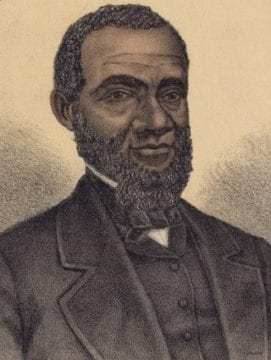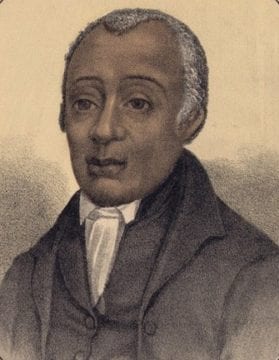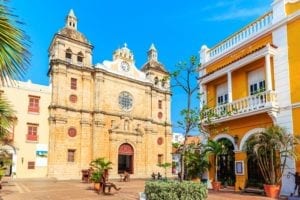In honor of Black History Month, here are significant mission events that happened on these dates in February involving African-Americans. These are just a few examples of what people of one racial background are doing to fulfill the Great Commission.
February 1, 1823
Betsey Stockton, a young black woman in company with 13 white missionaries, was on board a ship rounding the southern tip of South America. Those missionaries were on their way to the Sandwich Islands (present-day Hawaii). They had left New Haven, Connecticut in November, having been sent by the American Board of Commissioners of Foreign Missions, an agency at the forefront of American Protestantism’s burgeoning interest in foreign missions. Betsey Stockton was in the second group of missionaries to go to Hawaii, the first having gone two years before. Besides Stockton, this second group included six couples and a single man, plus three Hawaiian men and a Tahitian. The trip took five months by sea with no stopovers. Like several others on board, Stockton kept a journal of the voyage and of her first couple of months in Hawaii. She had joined the company partly as a missionary and partly as a servant to one of the couples, Rev. and Mrs. Charles S. Stewart, who were expecting a child. However, Betsey’s contract with the American Board did make clear that she was not to be simply a servant but was also to share in the mission’s primary work.
February 2, 1911
During a morning devotional hour at Central Texas College in Waco, a teacher, Eliza George, had a vision of black Africans passing before the judgment seat of Christ. Weeping and moaning, many of them were saying to Him, “No one ever told us You died for us.” A few years earlier, while a student at Guadalupe College, Eliza George had responded to an invitation for volunteer missionary service. Now, she felt a vision was prodding her to go to Africa. The Central Texas College president tried to dissuade her: “Don’t let yourself get carried away by that foolishness. You don’t have to go over there to be a missionary — we have enough Africa over here.” It would be two more years before Eliza George got up enough courage to leave her teaching position and head to Liberia. In her resignation speech, she read an original poem: “My African brother is calling me; Hark! Hark! I hear his voice . . . Would you say stay when God said go?” On December 12, 1913, Eliza George sailed from New York as a National Baptist missionary.
February 4, 1786
John Marrant, a free black from New York City, preached at Green’s Harbour, Newfoundland, from 2 Corinthians 13:5 to “a great number of Indians and white people.” Marrant’s ministry was cross-cultural with most of it being to Native Americans (or First Nations as they are often called in Canada). He eventually carried the gospel to the Cherokee, Creek, Catawar, and Housaw tribes.
February 5, 1884
Evangelist and missionary Amanda Berry Smith (1837-1915) was in Africa after having spent some time in India. In her journal entry for this particular day she wrote: “Second Gospel Temperance meeting. Surely the Spirit of the Lord is with us, and He is blessing us greatly. Not so much liberty in speaking, but God is with us, and we are expecting great things. Oh, Lord, for Jesus‘ sake, answer prayer, and send us the Holy Ghost to quicken and revive us.”
February 7, 1930
In a service commemorating fifty years of Congregational missions in Angola, the Galangue mission choir, under the leadership of Bessie McDowell, introduced a new song. It is Bessie’s own Ovimbundu translation of “Lift Ev’ry Voice and Sing.” African-Americans called “Lift Ev’ry Voice and Sing” — which had been composed in 1900 by the brothers James Weldon and J. Rosamond Johnson — the “Negro National Anthem.” On this date, February 7, Henry Curtis McDowell, Bessie’s husband, wrote to African-American supporters to say that “Galangue has made the first step, so far as I know, in making ‘Lift Ev’ry Voice and Sing’ the international anthem.” The McDowells had gone to Angola in 1917.
February 8, 1847
African-American Robert Hill had been appointed to accompany some white missionaries to Africa for the purpose of assisting them. On December 17, 1846, they had sailed for the coast of Africa, from Providence, Rhode Island. On this day, February 8, they arrived in Monrovia, Liberia.
February 10, 1819
Around this time Moses Henkle becomes acquainted with what John Stewart, “Man of Color,” was doing to found a mission among the Wyandott Indians near Upper Sandusky, Ohio. Stewart, the first Methodist missionary to the Indians, had been converted in 1815 while drunk in a Methodist meeting in Ohio. Henkle’s work with Stewart gave credibility to Stewart’s ministry. The resulting publicity led to the organization of a Methodist missionary society in 1819 in New York City.

February 12, 1865
Presbyterian minister Henry Garnet becomes the first African American to preach a sermon to the U.S. House of Representatives. Born into slavery in Maryland in 1815, Garnet escaped to New England with his father when he was nine years old. In 1852 Garnet went to Jamaica as a Presbyterian missionary. Ill health forced his return to the U.S. in 1855 where he became very active in the abolitionist movement.
February 13, 1824
One hundred and five black emigrants from the U.S. arrive in Liberia on the ship Cyrus. They were received by Lott Cary and Colin Teague who had arrived three years earlier to begin an era of missionary expansion by American Negro Baptists. They were the first missionaries sent out by a black group, the Richmond African Baptist Missionary Society.
February 14, 1760
Birth of Richard Allen, founder in 1816 of the African Methodist Episcopal (AME) denomination. By 1886, the Church was the world’s largest denomination of African Americans. It had more than four hundred thousand members, nearly three thousand ordained ministers, more than three thousand church buildings, and had sent missionaries to Haiti, San Domingo, and Africa. In 1893 AME headquarters received a request from a group of Afro-Cubans to send missionaries to their island.

February 15, 1859
Death of John Day (born: 1797), Southern Baptist missionary to Liberia, Sierra Leone and Central Africa as well as one of the founding fathers of the country of Liberia. During his thirteen years in Africa, Day estimated he had preached to about 10,000 “heathen.”
February 16, 1922
About this date, Jamaican-born Montrose Waite received a letter from the Christian and Missionary Alliance mission board saying they wanted to send him as a missionary to Africa. Waite had won the battle against prejudice and rejection and even friends who urged him to the stay in the U.S., his adopted country. Waite would serve as a missionary in Sierra Leone and Liberia and would be instrumental in the founding of the Afro-American Missionary Crusade (1947) and the Carver Foreign Missions organization.
February 18, 1797
Birth of John Day, a “free person of color” who emigrated to Liberia in 1830 as a participant in the American Colonization Movement. In 1836 he became a missionary for the Triennial Convention of the American Baptists. When the Southern Baptist Convention was formed in 1845, its foreign mission board appointed Day as superintendent of Liberian missions, a post he held until his death in 1859. Day was also a signer of the Declaration of Independence of Liberia in 1847. In addition to his missionary work, he became Liberia’s second Supreme Court Justice. His brother Thomas was a well-known cabinet maker in North Carolina.
February 20, 2000
A heart attack claimed the life of Marilyn Lewis, volunteer at the United States Center for World Mission who helped lay the groundwork for their African American Mobilization Division. A school teacher in Pasadena, CA, Marilyn often spoke of her desire to serve as a missionary in Brazil, reaching the descendants of those who had come from Africa. Just prior to her unexpected death, Marilyn had written a call-to-action article: “Just look at an African-American church today and you can see testimony to our new era: richly decorated, air conditioned sanctuaries with carpeted floors are now quite common. Many drive to church in the latest model cars. Today, instead of working the tables at restaurants, many African Americans own them. God has blessed us. Now it is time for the African American to bless the world in evangelization efforts. In the past many African Americans cried because they could not become involved in missionary work. But now the doors are wide open and we are without excuse.”
February 22, 1880
Moses Ladejo Stone was ordained into the ministry in the First Baptist Church, Lagos (originally known as American Baptist Church) by William W. Colley. Colley, an African American, is thought to be the person to have served as an appointed missionary of both a white-administered missionary-sending agency and a black-administered missionary-sending agency. Colley began his missionary career in 1875. That year, he was appointed by the Southern Baptist Foreign Mission Board to serve in West Africa as assistant to W. J. David, a white missionary from Mississippi. In November of 1879, Colley returned to the United States convinced that many more blacks should be involved in international missions, especially in Africa. As Colley traveled back and forth across the country, he urged black Baptists to take an independent course in mission work and form their own sending agency. Colley was the primary force in the founding of the Baptist Foreign Mission Convention (BFMC) in 1880.
February 23, 1814
The foundation of the Baptist Mission in Jamaica had been laid by a few black and “coloured” men who had gone to the island from the United States in 1782. Some of them had been slaves who had been granted liberty by their owners. Some were Christians when they arrived in Jamaica, while others had been converted after their arrival. The most noted were George Lisle (the first ordained black in America), George Lewis, George Gibb and Moses Baker. It was chiefly through the urging of Moses Baker that the English Baptist Missionary Society began missionary work in Jamaica. The first missionary sent from England in response to Baker’s pleas was John Rowe, who landed at Montego Bay, February 23, 1814.
February 24, 1840
Evangelist George Brown, who established the Heddington mission station in Liberia, reported organizing a church among the Pessah people as a result of converting two tribal leaders — Baopgo and Peter — along with 34 of their people after a “God-palaver.”
February 25, 1890
By this time William Sheppard, who has been called the “Black Livingstone,” was on his way to the Congo on the steamship Adriatic as a Presbyterian missionary. Sheppard was sailing with white missionary Sam Lapsley.

February 29, 1581
The birth of Peter Claver in 1581 in Spain. Claver became known as “Slave of the Blacks” and “Slave of the Slaves.” A farmer’s son from Verdu in Catalonia, Claver studied at the University of Barcelona. At age 20, he became a Jesuit priest. Influenced by Saint Alphonsus Rodriguez, Claver went to South America as a missionary. He ministered to African slaves physically and spiritually when they arrived in Cartegena, Colombia. It is estimated by some that Claver converted 300,000 African slaves to Christianity. For 40 years he worked for humane treatment on the plantations. Claver organized charitable societies among the Spanish in America similar to those organized in Europe by Vincent de Paul. Claver said of the slaves, “We must speak to them with our hands by giving before we try to speak to them with our lips.” Peter Claver died on September 8, 1654 at Cartegena, Colombia of natural causes.
For more original content by Howard Culbertson like this, visit: home.snu.edu/~hculbert

Comments